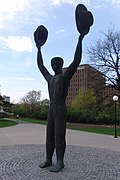
Commissioners Park is a park in Ottawa, Ontario, Canada. It lies within the westernmost section of The Glebe, bounded by Dow's Lake, Preston Street, Carling Avenue and Dow's Lake Road.
Contents
Throughout the warmer months it is a popular place for family walks. The National Capital Commission maintains the park and manages to keep flowers blooming there throughout the growing season. During the annual Canadian Tulip Festival, it is a major tulip viewing area with the highest concentration of tulips in the region numbering as many as 300,000.

